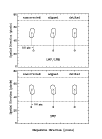 Figure 7.6:
Geometry of the spectrograph apertures as they
appear in the low-dispersion SI.
Figure 7.6:
Geometry of the spectrograph apertures as they
appear in the low-dispersion SI.
 Figure 7.6:
Geometry of the spectrograph apertures as they
appear in the low-dispersion SI.
Figure 7.6:
Geometry of the spectrograph apertures as they
appear in the low-dispersion SI.
The error introduced by extracting extended spectral data (data that
fills the large aperture) which has not been tilt corrected, by summing
the flux perpendicular to the dispersion can be estimated as follows.
The maximum tilt of the large aperture with respect to the dispersion
direction occurs in the SWP camera, with an ![]() angle of
81
angle of
81![]() . If the length of the large aperture is taken to be 14.2
pixels (based on a plate scale factor of 1.53 arcsec/pixel), then the
displacement from the line perpendicular to the dispersion direction is
1.1 pixels at each end of the aperture, or approximately 1.9Å.
Spectral features will show some broadening if extracted perpendicular
to the dispersion (
. If the length of the large aperture is taken to be 14.2
pixels (based on a plate scale factor of 1.53 arcsec/pixel), then the
displacement from the line perpendicular to the dispersion direction is
1.1 pixels at each end of the aperture, or approximately 1.9Å.
Spectral features will show some broadening if extracted perpendicular
to the dispersion (![]() ), which will amount to a
broadening of the base of the point spread function by 3.8Å. The
overall effect is in reality not as severe as a simple convolution of
the data with a 3.8Å wide slit, because the part of the signal
extracted near the slit center is not really being degraded. A more
precise approximation to the error is to think of the 10Å slit width
as being convolved with a triangular function with FWHM of 2Å and a
base width of 4Å, which will result in a degradation in resolution of
20-25%.
), which will amount to a
broadening of the base of the point spread function by 3.8Å. The
overall effect is in reality not as severe as a simple convolution of
the data with a 3.8Å wide slit, because the part of the signal
extracted near the slit center is not really being degraded. A more
precise approximation to the error is to think of the 10Å slit width
as being convolved with a triangular function with FWHM of 2Å and a
base width of 4Å, which will result in a degradation in resolution of
20-25%.
Since this is a significant effect, a correction is made to ``detilt'' the large-aperture data for observations that result in the detection of spatially extended spectra. This correction is obviously not necessary for point source spectra, nor is it appropriate for most trailed or multiple observations because in these types of observations the source is moved along the FES x-axis which is nearly perpendicular to the dispersion direction. Multiple spectra acquired along the major axis of the aperture, however, are tilt corrected. The tilt correction is not applied to any non-multiple spectrum having object class designation 10-57 (stellar sources), regardless of whether the spectrum is determined to be point or extended. Presumably a stellar spectrum measured to be extended is saturated.
The tilt correction is only applied to a region of the low-dispersion SI that extends for 18 image lines on either side of the predicted center of the large aperture, thus leaving the small-aperture data intact. The extent of the correction region was chosen so as to include the areas on either side of the aperture which are used for background subtraction in the subsequent extraction step of the image processing. The actual correction is accomplished by simply shifting each image line in the dispersion direction by an amount given by:
![]()